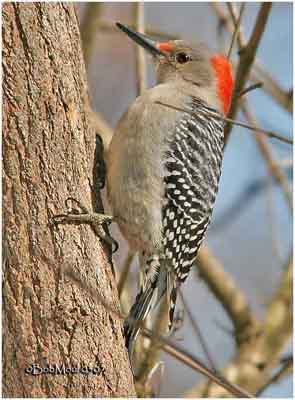
Red-bellied Woodpecker
Melanerpes carolinus
Piciforme Order – Picidae Family
BIOMETRICS:
Length: 24 cm
Wingspan: 33 à 42 cm
Weight: 56 à 91 g
LONGEVITY: Up to 12 years
DESCRIPTION:
Red-bellied Woodpecker male has red crown, forehead and nape. Its upperparts are streaked black and white. We can see a reddish patch on ventral region. Face and belly are dull grey. Uppertail coverts are white. Central tail feathers are barred black and white.
Red-bellied Woodpecker has a long, chisel-shaped bill. Bill and eyes are black. Legs and feet are dark grey. Feet are zygodactyls, with 2 toes forward and 2 backward.
Female has only red nape and feathers above the bill.
Juvenile is similar to adults, but its bill is horn-coloured, and it has brownish crown.

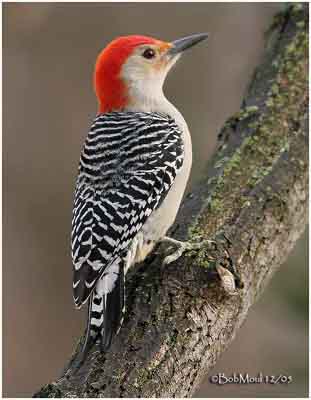
VOICE: SOUNDS BY XENO-CANTO
Red-bellied Woodpecker’s call is a rolling “churr-churr”, and cackling “kek-kek”, and some “cha” notes. It uses six different calls to communicate.
HABITAT:
Red-bellied Woodpecker is found in open and swampy woodlands. It prefers forests, swamps or wooded suburban habitats. It lives below 600 metres elevation, but it can be found at up to 900 metres in mountains.
RANGE:
Red-bellied Woodpecker lives in the eastern half of United States, except for northern New England.
BEHAVIOUR:
Red-bellied Woodpecker is resident in its range. Northern populations may move to South if winter is cold.
It is a diurnal bird. It walks, climbs and hops. Another form of locomotion is called “hitching”, consisting of hopping upward along a tree-trunk, with some pauses to search food.

Red-bellied Woodpecker is a solitary bird, except during breeding season. It is monogamous. Male attracts female performing tapping, “kwirr” calls, and drumming. Mates may make mutual tapping to communicate between them and during the nest-site selection. This mutual tapping is ritualized. Male or female taps softly from inside a cavity and the other bird taps from the outside.

Courtship also includes V-shaped flights. Breeding pairs stay together during one season.
Red-bellied Woodpecker defends its territory all year round. Conflicts are common between them, involving chase and collisions in mid-air. They have many threat displays, such as to rise feathers on neck and crown, and spreading wings and tail to appear larger.
When they are threatened, Red-bellied Woodpeckers utter alarm calls, and retreat in trees or scrubs. But when predators are not around, they may play, flying spontaneously and dodge among trees.
To feed, Red-bellied Woodpecker gleans, probes, excavates, pecks, scales the bark, and hawks. It swallows the whole prey. Larger preys are trashed against a tree, and pecked at.
Red-bellied Woodpecker has a long, cylindrical, pointed and sticky tongue, well adapted for excavating preys from bark crevices. Female has smaller tongue than male.
They store food for later, in cracks and crevices of trees, but they don’t defend their caches from other birds.

FLIGHT:
Red-bellied Woodpecker’s flight is strong and sustained.
REPRODUCTION:
Both parents select the nest site, and excavate the cavity. Nest is excavated in dead trees or branches. Cavity is lined with wood chips.
Female lays 3 to 8 smooth and glossy white eggs. Incubation lasts about 12 to 14 days, by both parents, male during the night.
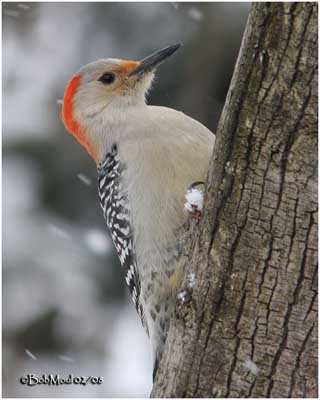
Before hatching, chicks utter some “pip”, coming from the egg. They are altricial, but open eyes, claws, rectrices and remiges begin to appear at six days. Feathers appear at about 10 to 12 days after hatching. Young have their whole plumage at 21 days old.
They vocalize during all their growth, fed by both parents. They begin to fledge at about 24 to 27 days old.
They remain near the nest for few days more, and then, they follow their parents. They are fed for up to 10 weeks. At the end of this period, adults drive them away. Young can breed the next spring.
This species may produce occasionally two clutches per season, but usually, they raise one single brood.
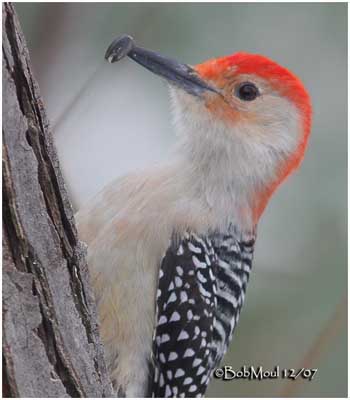
DIET:
Red-bellied Woodpecker feeds on fruits, nuts, seeds, berries and tree sap, arthropods and invertebrates (ants, flies, grasshoppers, beetle larvae) and caterpillars. They can also consume frogs, fish, nestlings and eggs.
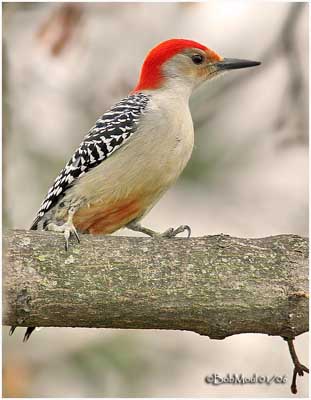
PROTECTION/THREATS/ STATUS:
Red-bellied Woodpecker is preyed upon by birds of prey, rats, snakes and domestic cats.
Populations have increased in recent years. This species is very adaptable and can inhabit a variety of different forest or other areas.
Fr: Pic à ventre roux
All : Carolinaspecht
Esp : Carpintero de Carolina
Ital : Picchio della Carolina
Nd : Roodbuikspecht
Sd : Karolinaspett
Photographs by Bob Moul
His website :
Nature Photography
Text by Nicole Bouglouan
Sources :
HANDBOOK OF THE BIRDS OF THE WORLD Vol. 7 by Josep del Hoyo-Andrew Elliott-Jordi Sargatal – Lynx Edicions – ISBN: 8487334377
FIELD GUIDE TO THE BIRDS OF NORTH AMERICA by National Geographic Society - National Geographic Society - ISBN: 0792274512
All About Birds (Cornell Lab of Ornithology)
Animal Diversity Web (University of Michigan Museum of Zoology)
What Bird-The ultimate Bird Guide (Mitchell Waite)
Wikipedia (Wikipedia, The Free Encyclopedia)